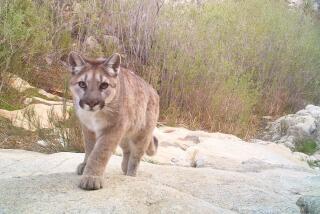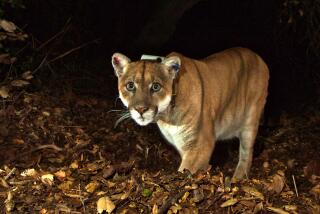State officials see merit in extra protections for Southern California mountain lions
State officials on Wednesday concluded that several cougar clans in Central and Southern California may warrant listing as threatened under the state Endangered Species Act, a step that could limit highway construction and development on thousands of acres of real estate.
Mountain lions are not a threatened species in California, but the determination submitted to the state Fish and Game Commission points out that six isolated and genetically distinct mountain lion populations from Santa Cruz to the U.S.-Mexico border make up a subpopulation that is threatened with extinction.
The California Department of Fish and Wildlife reviewed the species’ status in response to a petition submitted by the Center for Biological Diversity and the nonprofit Mountain Lion Foundation, which argued that the populations constitute an “evolutionary significant unit” that should be listed as state endangered.
“California’s mountain lions are being poisoned by rodenticides, hit by cars and legally shot with depredation permits,” said J.P. Rose, an attorney at the Center for Biological Diversity. “As sprawl development has fragmented their habitat, inbreeding could wipe out isolated mountain lion populations if nothing is done.
“We’re elated that state officials agree that the status quo is unacceptable,” he added, “and we urge California to quickly finalize protections for these iconic animals.”
The state commission is expected to vote April 15 on whether to formally grant the populations status under the state Endangered Species Act.
If the commission agrees, the California Department of Transportation would not be allowed to build or expand highways in core mountain lion habitat without implementing adequate measures to ensure habitat linkages and safe passage under or over them.
In addition, large-scale commercial and residential development could be limited in mountain lion habitats within a region covering roughly a third of the state.
The protection, if approved, will probably send stakeholders on all sides rushing to state courts and the Legislature.
There is no reliable estimate of how many mountain lions roam California today. But a rough estimate of 6,000 big cats statewide are legally classified as a “specially protected species” by the Department of Fish and Wildlife.
California voters banned mountain lion hunting in 1990.
The concept of an “evolutionarily significant unit,” or ESU, is not new. In 2005, the U.S. Fish and Wildlife Service listed California’s Central Coast population of coho salmon as federally endangered. A year ago, the southern Sierra Nevada population of the Pacific fisher became the first ESU mammal listed as a state threatened species.
In the meantime, the number of mountain lions in Southern California continues to plummet in the Santa Ana, San Gabriel, San Bernardino, Santa Monica, Santa Cruz and Tehachapi mountains.
The greatest concern for the long-term health of mountain lions in the national forests of Southern California is loss of landscape connectivity between ranges and large blocks of open space on private land, according to an environmental review of land management plans conducted by the U.S. Forest Service.
Mountain lion advocates say local governments are adding to this fragmentation. The Los Angeles County Board of Supervisors a year ago approved a proposal to develop 1,330 acres near the community of Castaic. That came despite concerns by the Santa Monica Mountains Conservancy that it would degrade a wildlife linkage between Angeles National Forest and Los Padres National Forest.
Similarly, the board recently approved the proposed 12,000-acre Centennial development on the unincorporated northern fringe of the county, overlooking objections that it would sever a habitat linkage between Highway 14 and Interstate 5.
On Monday, the Santa Monica Mountains National Recreation Area announced that a young mountain lion it had monitored since 2017 had been killed under a law allowing property owners to slay big cats that hurt livestock or pets, if other deterrents have failed.
The 4- or 5-year-old lion, identified as P-56, was believed to be the father of four offspring and was living south of the 101 Freeway in the western area of the Santa Monica Mountains.
In response to that killing, Joseph T. Edmiston, executive director of the Santa Monica Mountains Conservancy, has offered to personally reimburse livestock owners for losses attributable to lion predation in the region. On Wednesday, Los Angeles city leaders said they want to halt the issuance of depredation permits, which allow lethal action against cougars.
Statewide, an estimated 100 “nuisance” mountain lions are eliminated annually under such permits, officials said.
If the state listed the cougars as threatened, Rose said, it would “likely constrain the issuance of depredation permits to kill mountain lions in protected populations.”
Traffic also takes a significant toll. In the Santa Monicas, the 101 Freeway exists as a near impenetrable barrier to gene flow for a group of about 10 mountain lions. In the Santa Anas, the 15 Freeway limits the movement of a family of 20 cougars.
Since National Park Service biologists began researching pumas in the Santa Monicas in 2002, motorists have struck and killed more than 17 of the large predators in the study area, federal officials said.
“These amazing animals face huge threats that could wipe out key populations,” said Tiffany Yap, a biologist at the Center for Biological Diversity. “We urge the state to finalize these protections quickly so mountain lions can thrive in California for generations to come.”







